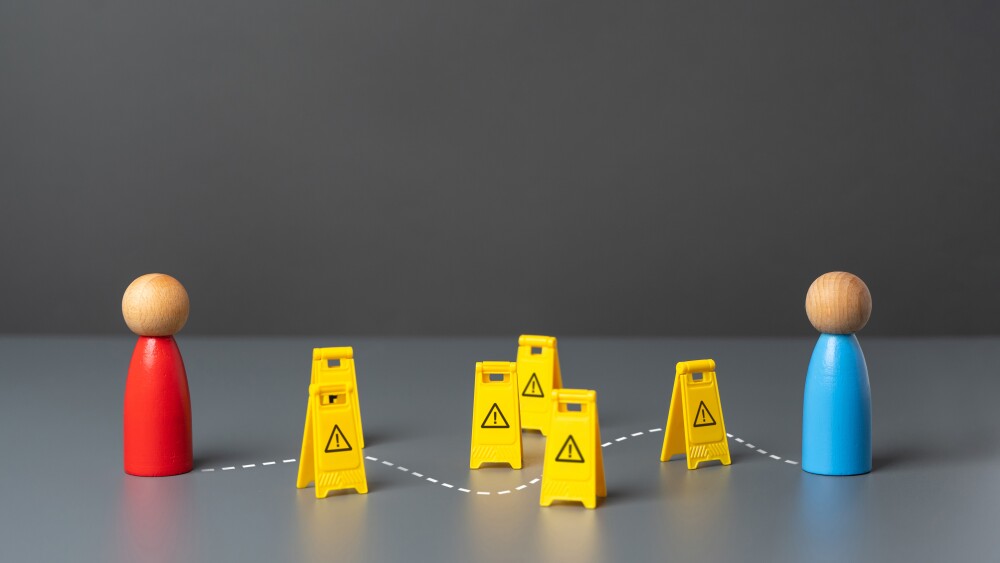Here’s how some biopharmas have managed to gain funding despite a falloff in investment in the sector. Hint: Positive late-stage data is a key factor.
Pictured: A cartoon depicting one person with a large pile of coins and another with a smaller pile/iStock, Vectorpower
If you ask Mizuho Americas’ Graig Suvannavejh to describe the biopharma investing climate right now, he’ll say it’s “very challenging.”
The senior biopharmaceuticals and biotech financial analyst noted that this is in contrast to just a few years ago when investors found the industry an attractive alternative to sectors such as hospitality, oil and gas and airlines, which were hit hard by the pandemic. At that time, investors went into biotech, “which fueled . . . what I would consider a bit of a bubble in terms of new company creation, the number of IPOs and how much money was being raised,” Suvannavejh told BioSpace.
In the current climate, there are several factors Suvannavejh believes are contributing to challenges with getting funding: high interest rates, geopolitical risk related to the war in Ukraine and China/Taiwan tension, the approaching election and rhetoric politicians are using about pharma companies on the campaign trail, and the potential for drugs to make less money if they are subject to price negotiation under the Inflation Reduction Act (IRA).
Despite this tough investing environment, a select few companies are still managing to secure hundreds of millions in funding. One early example came in August 2022 when Karuna Therapeutics raised $862.5 million in funding after publishing promising Phase III trial data on a drug to treat schizophrenia. Its competitor, Cerevel, which has a similar program targeting the same disease, raised $554 million in a piggybacking event after this data was published, Suvannavejh said.
This highlights the first trend he sees with companies that are managing to win funding today, a trend that remains constant: Good data—more specifically, good, late-stage data—almost always secures funding.
In another example, argenx released very positive Phase II data in July for its lead program, VYVGART. The drug is already FDA-approved for the autoimmune disorder myasthenia gravis, and the new data indicated it may be effective against other diseases as well, enabling the company to secure $1.27 billion in funding, Suvannavejh said.
In addition to this, Suvannavejh said there are a few other drug categories that have the best potential to defy current funding trends because of growing interest from investors:
GLP-1 Agonists for Obesity and Diabetes
- Reasoning: “All the attention is going to [Novo] Nordisk and Eli Lilly [producers of GLP-1 agonists Ozemic and Wegovy] and how great the market opportunity is for their drugs that are on the market, and people are talking about a $100 billion market potential,” Suvannavejh said.
- Indicator: Structure Therapeutics raised $300 million last week after releasing promising Phase I data for a GLP-1 agonist candidate similar to Ozempic and Wegovy that would be ingested as a pill rather than injected.
Treatments for Neurodegenerative Diseases
- Reasoning: There seems to be growing interest in funding companies in this space despite the fact that the risk is quite high, Suvannavejh said. “But what we’ve also seen is the FDA showing a larger degree of what I describe as regulatory flexibility.” For example, the controversial approval of Biogen’s Aduhelm for Alzheimer’s in 2021. “I think there’s increased interest in the neurodegenerative disease space because the unmet medical need is high. . . . We don’t have really good drugs, and the FDA is saying, ‘You know what, we’ll look at alternative things to make sure we get drugs for these patients.”
- Indicator: In April of this year, the FDA approved Biogen and Ionis’ Qalsody as the fourth-ever therapy for amyotrophic lateral sclerosis (ALS), despite previously reported negative Phase III efficacy data.
Autoimmune and Inflammatory Disease Drugs
- Reasoning: “The key to those drugs is they work in lots of different diseases,” Suvannavejh said. For example, AbbVie’s Humira was initially greenlit for treating rheumatoid arthritis but was later approved for use in more than 10 diseases and at its peak had annual sales of $20 billion. “So if you can get a drug in autoimmune diseases [where] there seems to be a central mechanism of action and it can treat lots of diseases, you can generate lots of sales,” Suvannavejh said.
- Indicator: Acelyrin, a late-stage, immunology-focused biopharma, raised $621 million in its IPO in May.
Cancer Drugs
- Reasoning: There is a high unmet medical need with a large potential population; cancer is the third leading cause of death worldwide.
- Indicator: Merck’s Keytruda raked in $20.9 billion in sales in 2022.
Mollie Barnes is a freelance science writer based in Los Angeles. Reach her at mollie@100yearsco.com. Follow her on Threads and Instagram @shejustlikedtogo and see more of her work at molliebarnes.contently.com.






